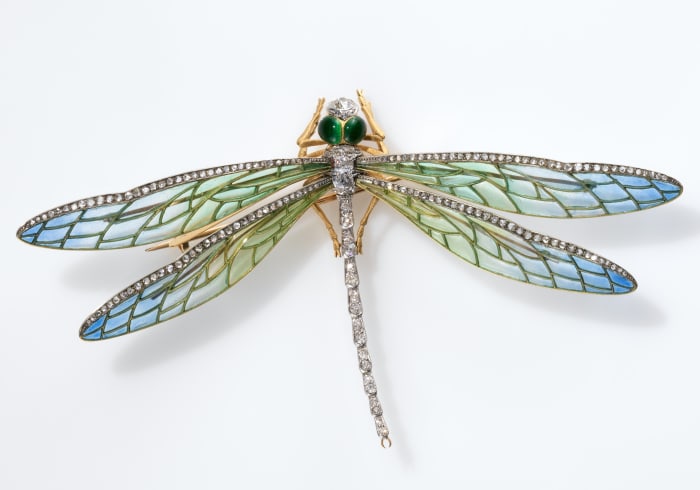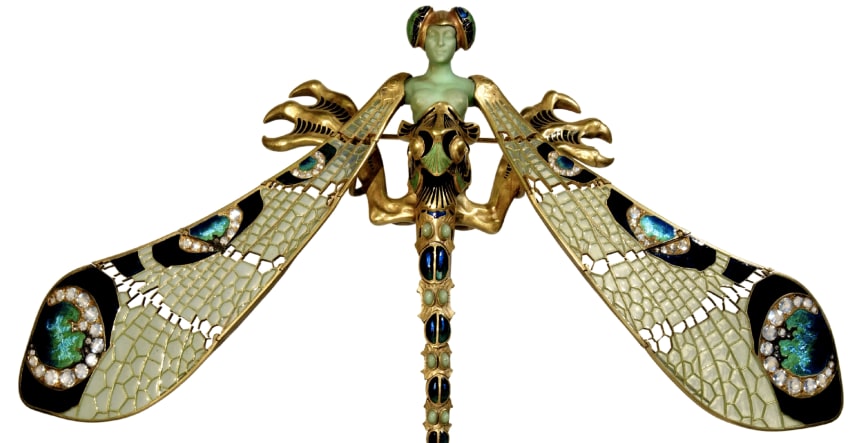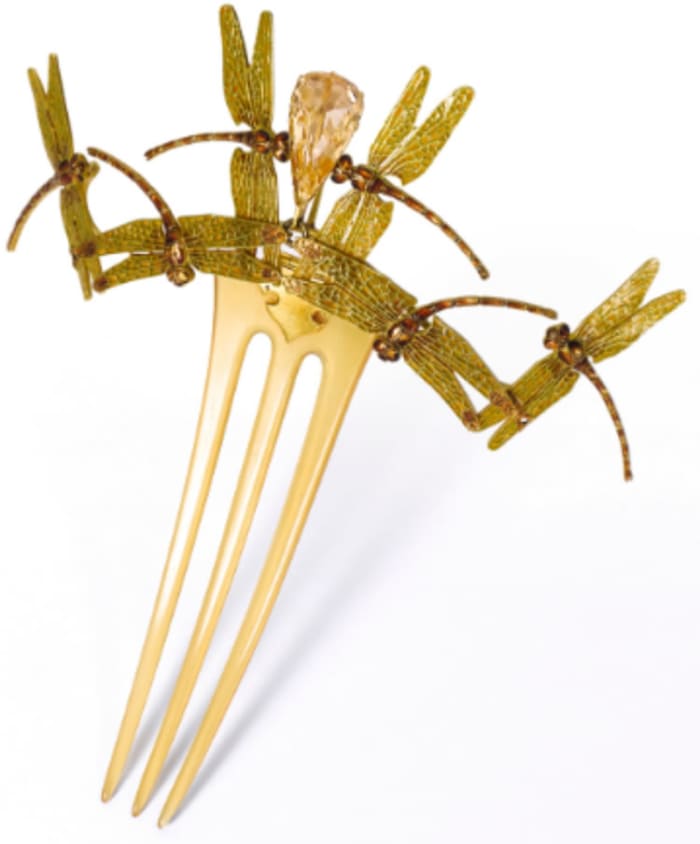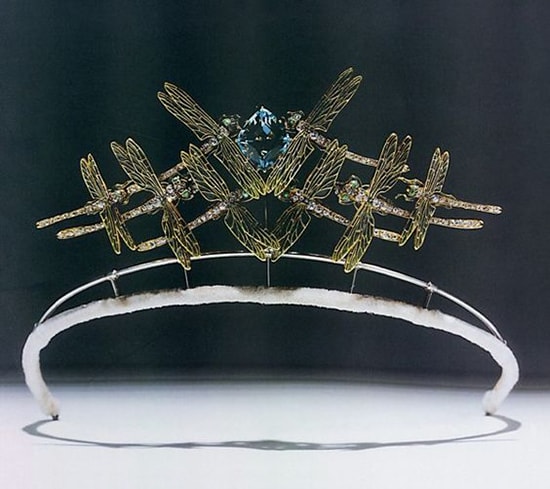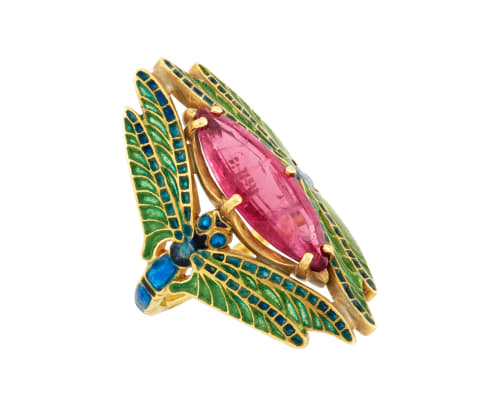In existence for more than 300 million years, dragonflies have been revered by humans for centuries. They are viewed as a symbol of courage, strength, wisdom, change and transformation and happiness.
This fascinating insect was first adopted as being a symbol of deeper meaning in eighth-century Japan. It was believed in mythology to be the spirit of the rice plant and a harbinger of rich harvests, and it was a symbol of the power of the Yamato court and mentioned in later poems set to music.
As a design motif, it appears on Japanese lacquerware, metalwork and porcelain and in colored woodcuts. It is one of the insects most beloved by Japanese children and thought to be their protector.
The dragonfly came to Western art much later, likely in the 1860s, when Japonisme became a craze after trade with Japan opened up. It was used by Christopher Dresser, the English designer, and his friends in the Aesthetic Movement from 1860-1900, which aimed to escape the ugliness and materialism of the Industrial Age, by focusing instead on producing art that was beautiful.

An 18k yellow gold and silver brooch by René Lalique, embellished with diamonds, opals and enamel, early 20th century; $103,000.
Courtesy of Artcurial
Dragonflies became ubiquitous in the 1890s because they perfectly captured the ephemeral quality well suited to the turn of the century — life is short, so you must be as brilliant and beautiful as you can in the time you have.
Embracing all forms of nature, Art Nouveau jewelers were particularly inspired by the grace of the dragonfly, which embodies many of the themes that style evokes, including metamorphosis from one physical form to another. The dragonfly was considered especially beautiful for jewelry, as its outstretched wings, long posterior extremity, and solid body give it valuable properties for setting precious stones. The veins and slight translucency of its wings lend themselves perfectly to the enameling technique of plique-à-jour (French for “letting in daylight”). This is a vitreous enameling technique where the enamel is applied in cells, similar to cloisonné, but with no backing in the final product, so light can shine through the transparent or translucent enamel and form a beautiful stained glass-like appearance. Skilled Art Nouveau artists created wings so real, the insects looked like they could flutter to life and fly away.
This circa 1890 gold and diamond dragonfly brooch by Danish craftsman Edgar Bense, in the collection of the Metropolitan Museum of Art, epitomizes the Art Nouveau style, with its intricate plique-à-jour wings. The wings are also set en tremblant (to tremble), which causes them to flutter as delicately as real dragonfly wings do, and with its sparking rose-cut diamonds, this piece catches the light brilliantly, according to the museum.
Leading Art Nouveau jewelry designers, including Louis Comfort Tiffany, René Lalique, Lucien Guillard and Philippe Wolfe, produced stunning tributes to the dragonfly crafted in innovative materials.
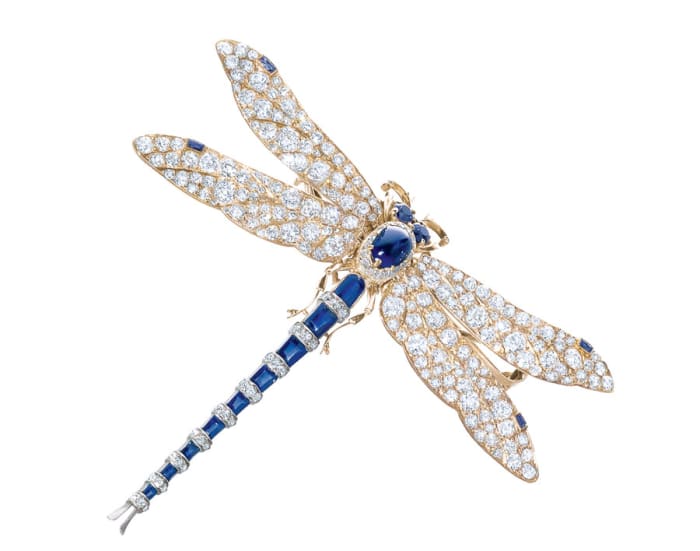
Tiffany & Co. archival dragonfly brooch with diamonds, sapphires, gold and silver, circa 1890-1900, by Paulding Farnham.
Courtesy of Tiffany
This dragonfly brooch above that’s in the Tiffany archives was designed around 1890 by little-known Tiffany artist Paulding Farnham. Though he was only in his 20s at the time, Farnham had already won a special medal for his jewelry at the Paris Exposition of 1889. His dragonfly creation has trembling wings of diamonds and sapphires and was designed to be worn at night, in candlelight. This show-stopper piece was meant to draw attention to the wearer and itself, according to Tiffany.
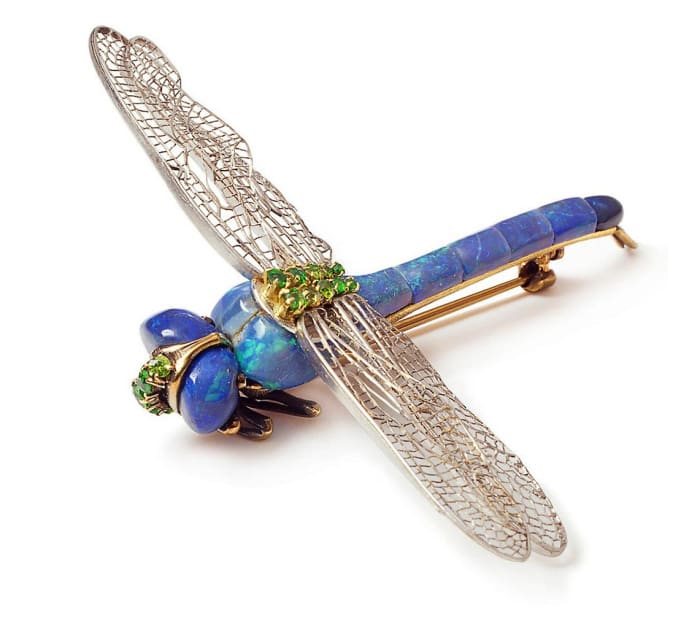
Black opals, demantoid garnets and platinum take flight in this dragonfly brooch by Louis Comfort Tiffany.
Courtesy of Tiffany
This small and more subtle dragonfly brooch was created by Louis Comfort Tiffany, the son of the company’s founder, and was meant to be worn during the day. Tiffany worked in virtually every media and is especially known for his leaded-glass windows and floral lampshades. He embarked on the design and fabrication of artistic jewelry just after the turn of the century and debuted it at the Pan-American Exposition in St. Louis in 1904. Nature was his muse throughout his long, productive career.
His own show-stopping dragonfly creation is the circa 1904 hair ornament in the collection of the Metropolitan Museum. According to the museum, it is one of his most remarkable works, capturing an ephemeral moment of two dragonflies alight on dandelion seed balls, one of which is partially blown away. Tiffany found beauty in one of the most common plants, seen not at the height of bloom but in a natural fading state, just before the seeds are scattered. The dragonflies feature shimmering black opals along their backs and dazzling pink opals as the heads, their coloristic properties evoking Tiffany’s famed iridescent glass. Their delicate, gossamer-like metal filigree wings made with an alloy of iridium and platinum were likely intended to have slight movement — en tremblant — when the wearer turned their head.
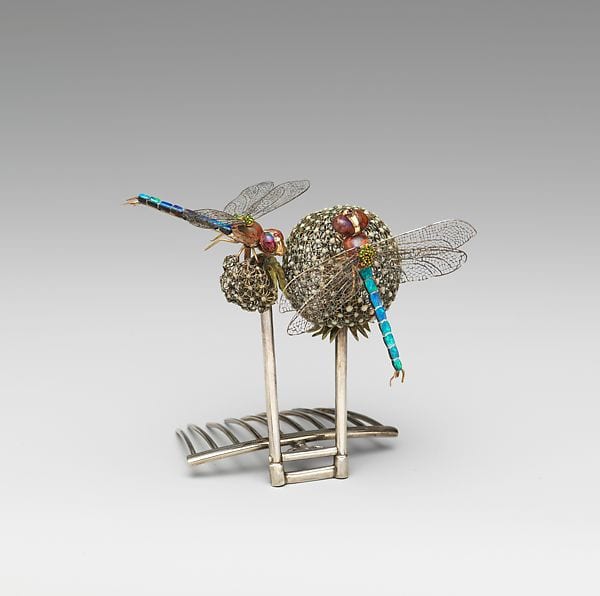
Hair ornament, c. 1904, Louis Comfort Tiffany, gold, silver, platinum, black opals, boulder opals, demantoid garnets, rubies, enamel, 3-1/4” h.
Courtesy of the Met Museum
Perhaps no other Art Nouveau jewelry designer was as inspired by dragonflies as René Lalique. A favorite motif of the French designer, considered the undisputed master of the genre, was the female figure with dragonfly wings. Lalique gave his dragonflies center stage in bracelets, brooches, necklaces, pendants and hair combs set with semi-precious stones such as moonstone and opals, and especially aquamarine gemstones, and embellished many with the soft natural tones of pearls.
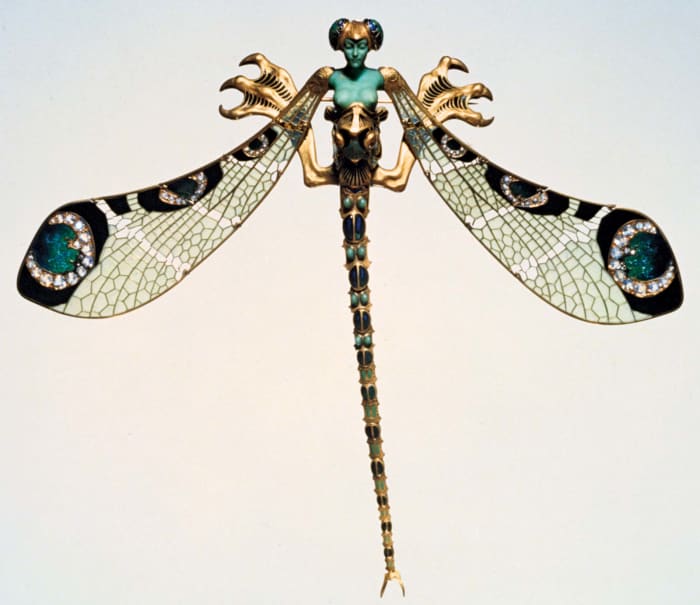
René Lalique Dragonfly Woman corsage ornament, made of gold, enamel, chrysoprase, moonstones, and diamonds, 1897-98.
Courtesy of the Gulbenkian Museum, Lisbon
This “Dragonfly Woman” corsage ornament, circa 1897-98, is considered one of the most spectacular pieces of jewelry Lalique ever created. According to the Gulbenkian Museum in Lisbon, which has this in its collection, the brooch was presented with enormous success at the Paris Universal Exhibition in 1900, where the artist’s Art Nouveau jewelry in general was met with great acclaim. The hybrid figure, at once beautiful and a bit grotesque, consists of an enormous gold and enamel dragonfly bearing articulated open wings, with extremely fine opaline enamel decoration enriched by diamonds, enamel work and moonstones.
From the gaping mouth of the insect, with its griffin’s claws, a female bust of semi-precious apple-green chrysoprase emerges, her head covered by a helmet decorated with two beetles in enameled gold. The slender body of the insect, also in enameled gold, features chalcedony en cabochon. The wings are hinged in four places and the tail bends, allowing this enormous ornament, which is 9 inches high and 10-1/2 inches wide, to adjust to and move with the body of the person who wore it.
The museum says that combining the female figure with the insect, which attracts and repels at the same time, and, in becoming a hybrid creature with ferocious griffin’s claws, the world of contrast and opposites that is so typical of the taste of the era finds its highest example in this piece of jewelry.
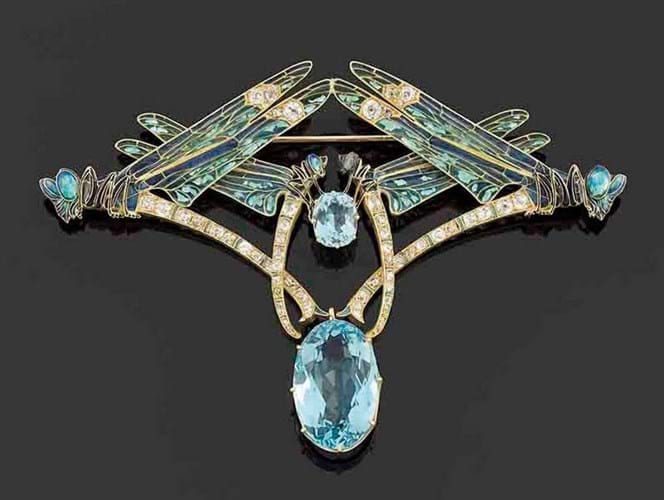
Lalique “four dragonflies”gold and aquamarine brooch with plique-à-jour enamel for the wings, c. 1900; $271,630.
Courtesy of Pescheteau Badin
In December 2020, this Lalique “four dragonflies” gold brooch was the star lot of an auction at Pescheteau Badin in Paris when it sold for $271,630. The circa 1900 brooch uses the signature techniques employed by Lalique at the time, most notably plique-à-jour enamelwork to create the effect of the insects’ iridescent wings. The piece is also set with diamonds and has a large cushion-shaped aquamarine in the center. It sold within its estimate of around $236,000 to $354,000.
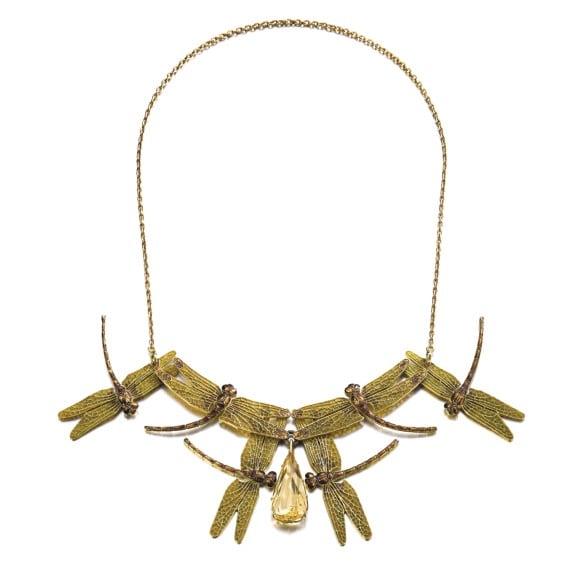
Lalique gold, enamel and citrine necklace/hair comb combination, c. 1900; $262,269.
Courtesy of Sotheby’s
This rare piece by Lalique, circa 1900, is designed as a swarm of brown enamel dragonflies with golden plique-à-jour enamel wings flitting around the light source of a pear-shaped citrine drop. The pendant has a comb fitting and pulls double duty by also being wearable as a hairpiece.
For this tiara, c. 1900, Lalique has a swarm of eight dragonflies around a glittering aquamarine stone. Hair ornament collector and expert Barbara Steinberg gives a great breakdown of this piece on her blog.
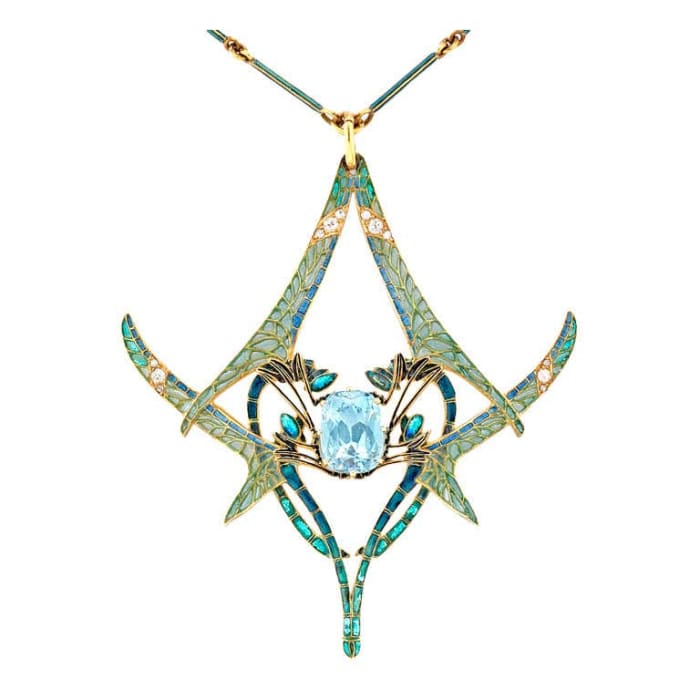
Lalique pendant featuring four dragonflies around an aquamarine stone, c. 1905; $275,152.
Courtesy of Bentley & Skinner
According to Bentley & Skinner, the London jewelers by appointment to Queen Elizabeth, the above spectacular Lalique dragonfly pendant “is a masterpiece of both Lalique and of Art Nouveau: it blurs the lines between fine art and applied art.” The circa 1905 pendant, which they are offering at 1stDibs.com for $275,256, has a cushion-shaped aquamarine as its center stone and four naturalistic dragonflies, each decorated with Lalique’s signature plique-à-jour enamel; it’s around 20 inches long.
Here are some additional pieces by Lalique and other Art Nouveau jewelry designers that celebrate the dragonfly in all of its beauty:


